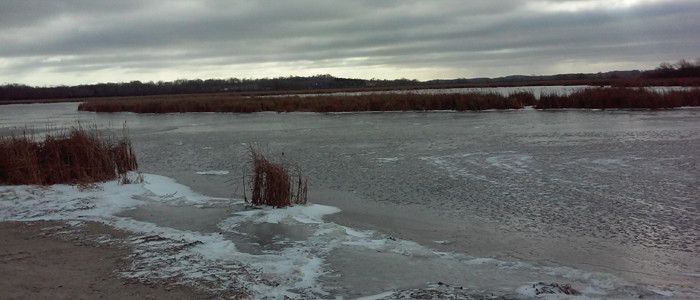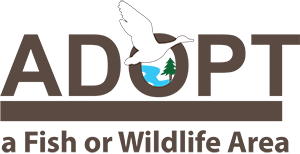Kiel Marsh Wildlife Area

Kiel Marsh Wildlife Area is an 843-acre property located just south of the city of Kiel in east-central Wisconsin. The property lies at the junction of Sheboygan, Calumet, and Manitowoc counties. Since there are no roads bordering it, the main public access to the marsh is on the north end of the property using the boat access and parking area located at the south end of 8th Street in the city of Kiel. A smaller and less developed boat access and parking area are on the southwest side of the property at the north end of Highview Road (about 3 miles north of Elkhart Lake). These boat accesses provide users the means to get onto the Sheboygan River by boat, canoe, skiff, or kayak.
The Sheboygan River meanders lazily for 3 miles through the entire length of the property. An extensive shallow water marsh of cattail and other emergent aquatic plants parallels the main river channel on both sides providing habitat for numerous species of waterfowl and shorebirds. Lowland brush intermixed with sparse stands of northern white cedar and hardwoods can be found in the adjoining lowland providing habitat for white-tailed deer, woodcock, wild turkey, small game and furbearers.
History
The marsh was formed during the Pleistocene period of the Great Ice Age and is located between the Green Bay and Lake Michigan lobes of the Wisconsin ice sheet. That glacier receded about 11,000 years ago and left behind the interesting topography of moraines in the Kiel Marsh vicinity. These moraines are unique because they were formed by the accumulation of glacial till that occurred between the two ice lobes. Along State Highway 67 on the east side of the marsh are gravelly, steep-sided depressions known as kettles. These kettles formed when buried ice blocks melted and left depressions in the glacial debris. To the north are low, elongated, half-egg-shaped hills known as drumlins. Drumlins contain glacial till that formed in hills parallel to the direction in which the glaciers retreated. To the east are eskers, which were formed by glacial melt-water streams that flowed in tunnels beneath the ice sheet.
Early inhabitants here were the Fox and Sac Indians and later the Menominees, who undoubtedly used the marsh for hunting, trapping and fishing. A mill dam was built in Kiel during European settlement, which also served to control the water level of the marsh. Much of the marsh was managed as a private fur farm for about 20 years. Several level ditches were constructed during that time to increase furbearer and waterfowl habitat. In 1963, the Wisconsin Conservation Commission approved the project as a state wildlife area and 800 acres were acquired shortly thereafter by the state.
Management objective
Current management aims to stabilize water levels to benefit breeding and migratory marshland wildlife. Other management strategies of today include land acquisition, limited development and management practices that benefit furbearers, waterfowl and other game and non-game wildlife.
Small patches of lowland forest containing hardwoods are too small and remotely located in the marshlands to manage through modern sustainable forestry practices. The marsh water level is maintained by the city of Kiel using the control gates at the dam in Kiel. Invasive species monitoring — looking for purple loosestrife, phragmites and other exotics — is done every year.
For more information on master planning for this and other wildlife areas around the state, visit the property planning page.
Recreation
The Kiel Marsh Wildlife Area offers many recreational opportunities:
- Birding (chances to see black-crowned night heron, least bittern and black tern throughout the emergent marsh areas, plus yellow-billed cuckoo, willow flycatcher, veery and black-billed cuckoo, which are present during the breeding season in the shrub-carr and lowland forest areas)
- Canoeing (on the Sheboygan River, which flows the length of the property and on the remnant level ditches in the marsh)
- Cross-country skiing (no designated trail)
- Fishing
- Hiking (no designated trail)
- Hunting (especially noted for deer, turkey, waterfowl, rabbit, squirrel, woodcock, fox, coyote and raccoon)
- Snowmobiling (no designated trail)
- Trapping
- Wild edibles/gathering
- Wildlife viewing
Amenities
- Bathroom - none.
- Parking lot - two parking lots.
- Campground and size - none.
- Trails, Types and Lengths - none.
- Other amenities - a developed boat launch at the end of 8th Street and a primitive boat launch at the end of Highview Road.
Unique Considerations
Kiel Marsh is located within the "Mid to North Kettle Moraine" Conservation Opportunity Area [PDF] of Wisconsin's Wildlife Action Plan. In this plan, the marsh is noted as having continental-wide ecological significance because of its complexes of wetlands and rivers, which include shrub carr and emergent marsh. As noted in the plan, some of the Species of Greatest Conservation Need that are present here include willow flycatchers and veery. Several springs and seeps located along the marsh feed into the Sheboygan River. One of the most significant complexes of these, called Mehles Springs, is located just off the property to the southeast.
Friends Group
The Sheboygan County Conservation Association [exit DNR] has helped to finance various habitat management practices in the marsh throughout the years.
Maps
Download [PDF] a map of this property.
If you are interested in exploring this property further, you can access an interactive map.
Find out more about how to adopt this wildlife area.

